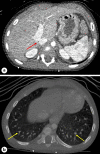Down Syndrome Patients with Congenital Portosystemic Shunts: A Case Report and Review
- PMID: 38111805
- PMCID: PMC10727516
- DOI: 10.1159/000535477
Down Syndrome Patients with Congenital Portosystemic Shunts: A Case Report and Review
Abstract
Introduction: Down syndrome is due to trisomy 21 and is characterized by intellectual disability, dysmorphic facial features, congenital malformations, and gastrointestinal abnormalities. There is an increased appreciation of congenital portosystemic shunts in Down syndrome patients. Congenital portosystemic shunts have been associated with many defects in body systems, including cardiac, metabolic, and neurological.
Case presentation: Herein, we describe a portosystemic shunt in a Down syndrome patient that resulted in hyperammonemia with altered mental status and choreiform movements. Computed tomography angiography of the abdomen and pelvis identified a connection between the right portal vein and inferior vena cava. An 18 mm Amplatzer PFO closure device was placed within the congenital shunt, significantly improving symptoms. The patient has no sequelae from the related shunt or the device at the 2-year follow-up. We extensively reviewed the literature and identified cases of portosystemic shunts in Down syndrome patients. Shunts can either be extrahepatic or intrahepatic and are classified by vasculature connections.
Conclusion: From our literature review and case presentation, we identify other conditions in patients, including cardiac and gastrointestinal defects. We then review the available treatment options, whether observation or surgical, depending on the patient's clinical picture.
Keywords: Case report; Congenital portosystemic shunt; Down syndrome; Hyperammonemia; Pediatrics.
© 2023 The Author(s). Published by S. Karger AG, Basel.
Conflict of interest statement
There are no conflicts of interest by any authors. There are no financial or nonfinancial relationships or activities to disclose that could be perceived as a conflict of interest.
Figures

Similar articles
-
Congenital portosystemic shunt occlusion with an Amplatzer PFO occlusion device: a case report.CVIR Endovasc. 2021 Jan 11;4(1):14. doi: 10.1186/s42155-021-00204-y. CVIR Endovasc. 2021. PMID: 33427962 Free PMC article.
-
Characterization and natural history of congenital intrahepatic portosystemic shunts.Eur J Pediatr. 2021 Jun;180(6):1733-1737. doi: 10.1007/s00431-021-03949-9. Epub 2021 Jan 22. Eur J Pediatr. 2021. PMID: 33481107
-
Congenital portosystemic shunts with and without gastrointestinal bleeding - case series.Pediatr Radiol. 2015 Dec;45(13):1964-71. doi: 10.1007/s00247-015-3417-6. Epub 2015 Jul 25. Pediatr Radiol. 2015. PMID: 26209117
-
The clinical anatomy of congenital portosystemic venous shunts.Clin Anat. 2008 Mar;21(2):147-57. doi: 10.1002/ca.20574. Clin Anat. 2008. PMID: 18161055 Review.
-
Congenital Extrahepatic Portosystemic Shunt (Abernethy Malformation Type Ib) With Associated Hepatocellular Carcinoma: Case Report and Literature Review.Pediatr Dev Pathol. 2017 Jul-Aug;20(4):354-362. doi: 10.1177/1093526616686458. Epub 2017 Jan 25. Pediatr Dev Pathol. 2017. PMID: 28727971 Review.
References
-
- Fabia J, Drolette M. Malformations and leukemia in children with Down's syndrome. Pediatrics. 1970;45(1):60–70. - PubMed
-
- Vis JC, Duffels MGJ, Winter MM, Weijerman ME, Cobben JM, Huisman SA, et al. . Down syndrome: a cardiovascular perspective. J Intellect Disabil Res. 2009;53(5):419–25. - PubMed
-
- Franchi-Abella S, Branchereau S, Lambert V, Fabre M, Steimberg C, Losay J, et al. . Complications of congenital portosystemic shunts in children: therapeutic options and outcomes. J Pediatr Gastroenterol Nutr. 2010;51(3):322–30. - PubMed
Publication types
LinkOut - more resources
Full Text Sources

